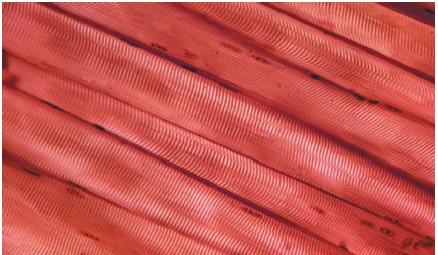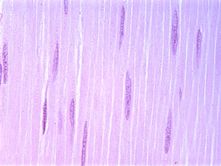|
| ||||||||||||
| muscle_notes.pdf | |
| File Size: | 3000 kb |
| File Type: | |
The Skeletal / Muscular System
Bones are classified by their shape. Four types of bones are long, short, flat, and irregular.
Muscles can be classified by the type of muscle tissue they are composed of. The three types of tissue are skeletal, smooth, and cardiac.
Muscles can be classified by the type of muscle tissue they are composed of. The three types of tissue are skeletal, smooth, and cardiac.
Skeletal MuscleLong cells (fibers), striated, multi-nucleated. Voluntary motor control. Used to move the skeleton and maintain posture.
|
Smooth MuscleSpindle-shaped cells, non-striated, uni-nucleated. Invountary motor control. Found in walls of hollow organs (blood vessels, viscera) to move fluids.
|
Cardiac MuscleTubular, branched, striated, uni-nucleated. Invountary motor control. Found in walls of the heart to cause contraction.
|
Anatomy of Skeletal Muscle

Skeletal Muscle is composed of many layers of fibers. At the smallest level, a muscle cell (fiber) is composed of bundles of the protein filaments, actin and myosin. These bundles of filaments are called myofibrils. Several myofibrils are bundled together to form a single muscle cell, also called a muscle fiber. The fiber is covered by a specialized endoplasmic reticulum, called the sarcoplasmic reticulum, which releases Calcuium ions during contraction. The fiber is suurounded by a plasma membrane, called the sarcolemma. Each muscle fiber is surrounded by a layer of connective tissue called the endomysium.
A bundle of muscle fibers is called a fascicle. Each fascicle is surrounded by a layer of connective tissue called the perimysium. A muscle is made up of many fascicles, which are all surrounded by a layer of connective tissue called the epimysium. The epimysium thickens to form a tendon as it connects the muscle to a bone.
A bundle of muscle fibers is called a fascicle. Each fascicle is surrounded by a layer of connective tissue called the perimysium. A muscle is made up of many fascicles, which are all surrounded by a layer of connective tissue called the epimysium. The epimysium thickens to form a tendon as it connects the muscle to a bone.
Contraction of Skeletal MuscleDuring the contraction of skeletal muscle, an electric action potential causes calcium to be released from the sarcoplasmic reticulum, resulting in the movement of proteins on the actin filaments, exposing a binding site for myosin crossbridges to attach. With energy supplied by the high energy bonds of ATP, the myosin heads pull and release the actin filament repeatedly, shortening the sarcomere. This action will continue until there is no more calcium present. Then, the filaments will release and the muscle will return to its relaxed state. During skeletal muscle contraction, none of the filaments actually shorten. The distance between z-lines (sarcomere) shortens.
|
|
Muscles of the Head and Neck
Watch the Power Point presentation to learn the location and function of the muscles of the head.
Muscles of the Posterior and Anterior Trunk |
| ||||||
|
Watch the Power Point presentation to learn the names, location, and function of the muscles of the posterior and anterior trunk.
| ||||||||
Muscles of the Upper and Lower Limbs
|
Watch the Power Point presentation to learn the names, location, and function of the muscles of the upper and lower limbs.
| ||||||||









